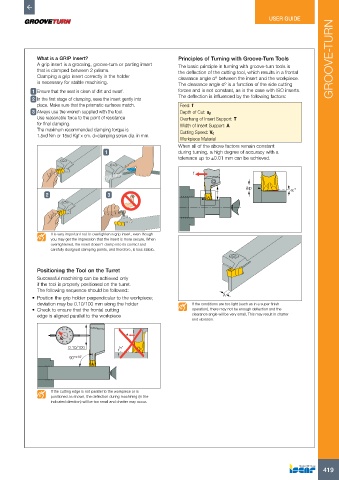Page 421 - ISCAR(TURNING-CATALOG-42-2022)
P. 421
USER GUIDE
What is a GRIP Insert? Principles of Turning with Groove-Turn Tools GROOVE-TURN
A grip insert is a grooving, groove-turn or parting insert The basic principle in turning with groove-turn tools is
that is clamped between 2 prisms. the deflection of the cutting tool, which results in a frontal
Clamping a grip insert correctly in the holder clearance angle αº between the insert and the workpiece.
is necessary for stable machining. The clearance angle αº is a function of the side cutting
1 Ensure that the seat is clean of dirt and swarf. forces and is not constant, as is the case with ISO inserts.
2 In the first stage of clamping, ease the insert gently into The deflection is influenced by the following factors:
place. Make sure that the prismatic surfaces match. Feed: f
3 Always use the wrench supplied with the tool. Depth of Cut: ap
Use reasonable force to the point of resistance Overhang of Insert Support: T
for final clamping. Width of Insert Support: A
The maximum recommended clamping torque is
1.5xd Nm or 15xd Kgf x cm. d=clamping screw dia. in mm. Cutting Speed: Vc
Workpiece Material
When all of the above factors remain constant
1 during turning, a high degree of accuracy with a
tolerance up to ±0.01 mm can be achieved.
f
ap α°
2 3 T
It is very important not to overtighten a grip insert, even though
you may get the impression that the insert is more secure. When
overtightened, the insert doesn’t clamp into its correct and
carefully designed clamping points, and therefore, is less stable.
Positioning the Tool on the Turret TEXT
Successful machining can be achieved only
if the tool is properly positioned on the turret.
The following sequence should be followed:
A
• Position the grip holder perpendicular to the workpiece;
deviation may be 0.10/100 mm along the holder If the conditions are too light (such as in a super finish
• Check to ensure that the frontal cutting operation), there may not be enough deflection and the
edge is aligned parallel to the workpiece clearance angle will be very small. This may result in chatter
and vibration.
30 40
20 50
f
10 60
70
0
90 80
0.10/100 α°
90° ±10'
If the cutting edge is not parallel to the workpiece or is
positioned as shown, the deflection during machining (in the
indicated direction) will be too small and chatter may occur.
419

